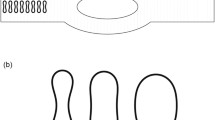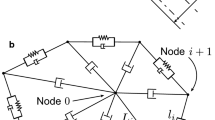Abstract
Availablein vitro andin vivo experimental observations suggest that red cell aggregation and blood vessel geometry are improtant determinants of the flow characteristics of blood in venules. However, no consistent relationship has been observed between red blood cell aggregation and vascular resistance. The present work attempts to understand this relationship by evaluating computationally the effect of red cell aggregation on the flow characteristics of blood in a converging vessel, bifurcation. The proposed mathematical model considers blood as a two-phase continuum, with a central core region of concentrated red cell suspension that is surrounded by a layer of plasma adjacent to the vessel wall. In the central core region, blood is described by Quemada’s non-Newtonian rheological model, in which local viscosity is a function of both the local hematocrit and a structural parameter that is related to the size of red blood cell aggregates. Fluids from the two feeding branches are immiscible, which results in a stratified multiphase flow in the collecting venule. Calculations predict a complex, three-dimensional pattern of blood flow and generally nonaxisymmetric distribution of velocity, hematocrit, and shear stress in the collecting venule. The calculations are a first step toward a realistic model of blood flow in the venous microcirculation.
Similar content being viewed by others
References
Alonso, C., A. R. Pries, and P. Gaehtgens. Time-dependent rheological behavior of blood at low shear in narrow vertical tubes.Am. J. Physiol. 265:H553-H561, 1993.
Bjornberg, J., M. Maspers, and S. Mellander. Metabolic control of large-bore arterial resistance vessels, arterioles, and veins in cat skeletal muscle during exercise.Acta Physiol. Scand. 135:83–94, 1989.
Carr, R. T. Estimation of hematocrit profile symmetry recovery length downstream from a bifurcation.Biorheology 26:907–920, 1989.
Cokelet, G. R. The rheology and tube flow of blood. In: Handbook of bioengineering, edited by R. Skalak and S. Chien. New York: McGraw Hill, 1987, pp. 14.1–14.17.
Cokelet, G. R., and H. L. Goldsmith. Decreased hydrodynamic resistance in the two-phase flow of blood through small vertical tubes at low flow rates.Circ. Res. 68:1–17, 1991.
Desjardins, C., and B. R. Duling. Microvessel hematocrit: measurement and implications for capillary oxygen transport.Am. J. Physiol. 252:H494-H503, 1987.
Diana, J. N., and C. A. Shadur. Effect of arterial and venous pressure on capillary pressure and vascular volume.Am. J. Physiol. 225:637–650, 1973.
Goldsmith, H. L., G. R. Cokelet, and P. Gaehtgens. Robin Fahraeus: evolution of his concepts in cardiovascular physiology.Am. J. Physiol. 257:H1005-H1015, 1989.
House, S. D., and P. C. Johnson. Diameter and blood flow of skeletal muscle venules during local flow regulation.Am. J. Physiol. 250:H828-H837, 1986.
House, S. D., and H. H. Lipowsky. Leukocyte-endothelium adhesion: microhemodynamics in mesentery of the cat.Microvasc. Res. 34:363–379, 1987.
Ivanov, K. P., Y. I. Levkovitch, E. P. Vovenko, and N. A. Maltsev. Separate flows of erythrocytes with different degree of oxygenation in blood vessels.Sechenov Physiol. J. USSR 76:338–344, 1990.
Johnson, P. C., M. Cabel, H. J. Meiselman, and A. S. Popel. Contribution of red cell aggregation to venous resistance in skeletal muscle.Biorheology 32:167, 1995.
Levtov, V. A., S. A. Regirer, and N. Kh. Shadrina. On red blood cell aggregation. In: Contemporary problems of biomechanics, edited by G. G. Chernyi and S. A. Regirer. Boca Raton: CRC Press, 1990, pp. 55–74.
Lipowsky, H. H. Mechanics of blood flow in the microcirculation. In: Handbook of bioengineering, edited by R. Skalak and S. Chien. New York: McGraw Hill, 1987, pp. 18.1–18.25.
Murata, T., and T. W. Secomb. Effects of aggregation on the flow properties of red blood cell suspensions in narrow vertical tubes.Biorheology 26:247–259, 1989.
Ong, J., G. Enden, and A. S. Popel. Converging three dimensional Stokes flow of two fluid in a T-type bifurcation.J. Fluid Mech. 270:51–71, 1994.
Popel, A. S., and G. Enden. Analytical solution for steady flow of Quemada fluid in a circular tube.Rheol. Acta 32: 422–426, 1993.
Pries, A. R., D. Neuhaus, and P. Gaehtgens. Blood viscosity in tube flow: dependence on diameter and hematocrit.Am. J. Physiol. 263:H1770-H1778, 1992.
Pries, A. R., T. W. Secomb, T. Gessner, M. B. Sperandio, J. F. Gross, and P. Gaehtgens. Resistance to blood flow in microvessels in vivo.Circ. Res. 75:904–915, 1994.
Quemada D. Blood rheology and its implications in flow of blood. In: Arteries and arterial blood flow; biological and physiological aspects, edited by C. M. Rodkiewicz. New York: Springer-Verlag, 1983, pp. 1–27.
Reinke, W., P. C. Johnson, and P. Gaehtgens. Effect of shear rate variation on apparent viscosity of human blood in tubes of 29 to 94 μm diameter.Circ Res. 59:124–132, 1986.
Reinke, W., P. Gaehtgens, and P. C. Johnson. Blood viscosity in small tubes: effect of shear rate on aggregation and sedimentation.Am. J. Physiol. 253:H540-H547, 1987.
Sato, M., and N. Ohshima. Effect of wall shear rate on thrombogenesis in microvessels of the rat mesentery.Circ. Res. 66:941–949, 1990.
Schmid-Schoenbein, G. W., Y. C. Fung, and B. W. Zweifach. Vascular endothelium-leukocyte interaction.Circ. Res. 36:173–184, 1975.
Schmid-Schoenbein, H. Microrheology of erythrocytes, blood viscosity, and the distribution of blood flow in the microcirculation.Intern. Rev. Physiol. 9:1–62, 1976.
Secomb, T. W., and A. W. El-Kareh. A model for motion and sedimentation of cylindrical red cell aggregates during slow blood flow in narrow horizontal tubes.J. Biomech. Eng. 116:243–249, 1994.
Soutani, M., Y. Suzuki, N. Tateishi, and N. Maeda. Quantitative evaluation of flow dynamics of erythrocytes in microvessels: influence of erythrocyte aggregation.Am. J. Physiol. 268:H1959-H1965, 1995.
Tateishi, N., Y. Suzuki, M. Soutani, and N. Maeda, Flow dynamics of erythrocytes in microvessels of isolated rabbit mesentery: cell free layer and flow resistance.J. Biomech. 27:1119–1125, 1994.
Tutty, O. R. Flow in a tube with a small side branch.J. Fluid Mech. 191:79–109, 1988.
Vanhoutte, P. M. Role of the veins in the circulation.Acta Cardiol. 36:239–248, 1981.
Woldhuis, B., G. J. Tangelder, D. W. Slaaf, and R. S. Reneman. Concentration profile of blood platelets differs in arterioles and venules.Am. J. Physiol. 262:H1217-H1223, 1992.
Yamaguchi, S., T. Yamakura, and H. Niimi. Cell-free plasma layer in cerebral microvessels.Biorheology 29:251–260, 1992.
Author information
Authors and Affiliations
Rights and permissions
About this article
Cite this article
Das, B., Enden, G. & Popel, A.S. Stratified multiphase model for blood flow in a venular bifurcation. Ann Biomed Eng 25, 135–153 (1997). https://doi.org/10.1007/BF02738545
Received:
Revised:
Accepted:
Issue Date:
DOI: https://doi.org/10.1007/BF02738545




